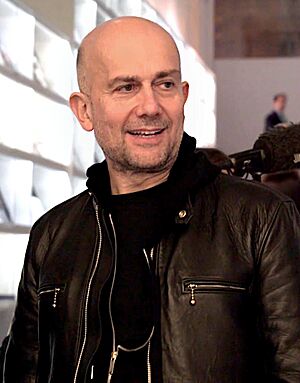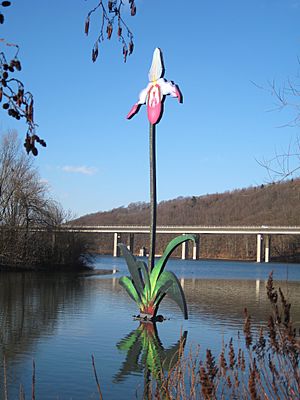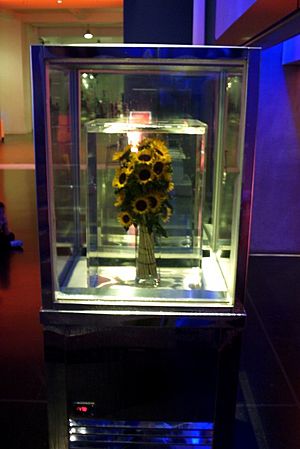Marc Quinn facts for kids
Quick facts for kids
Marc Quinn
|
|
|---|---|

Quinn in 2017
|
|
| Born | 8 January 1964 London, UK
|
| Education | Robinson College, Cambridge |
| Known for | Contemporary art, Young British artists |
| Awards | 2004 – 4th Plinth Commission for Trafalgar Square, London |
Marc Quinn (born 8 January 1964) is a famous British artist. He creates sculptures, installations, and paintings. Quinn's art explores what it means to be human today. He looks at topics like the body, our genes, and how we see ourselves.
His artworks use many different materials. These include blood, bread, flowers, marble, and stainless steel. Quinn has had solo exhibitions in major galleries. These include the Tate Gallery and the National Portrait Gallery. He was also a well-known member of the Young British Artists group.
Quinn is known around the world. In 2004, he was chosen for the first Fourth Plinth art project in Trafalgar Square. For this, he showed his sculpture Alison Lapper Pregnant. His famous series of self-portraits, Self, are made from his own frozen blood. These works were featured in a special exhibition in 2009.
Quinn lives and works in London.
Contents
Life and Art Journey
Marc Quinn was born in London on January 8, 1964. His mother was French, and his father was British. He spent his early years in Paris. His father was a physicist, working with scientific instruments. Quinn remembers being fascinated by these tools, especially atomic clocks.
He went to a private school called Millfield. Later, he studied history and history of art at Robinson College, Cambridge.
Starting His Career
In the early 1990s, Quinn was one of the first artists to work with gallery owner Jay Jopling. Quinn's first exhibition with Jopling was in 1991. He showed Self (1991), a self-portrait made from nine pints of his own frozen blood.
During the 1990s, Quinn and other artists became known for their new ways of making art. In 1992, a writer called them the 'Young British Artists'. This group included artists like Damien Hirst and Rachel Whiteread.
Major Exhibitions
In 1995, Quinn had a solo exhibition at Tate Britain. In 1997, his work Self (1991) was shown at the Sensation exhibition at the Royal Academy in London. This exhibition got a lot of attention and had many visitors. It later traveled to Berlin and New York.
Quinn continued to have many solo exhibitions. These included shows at the South London Gallery in 1998 and the Groninger Museum in 2000. In 2000, he also presented a large new work called Garden at the Fondazione Prada in Milan. In 2001, the National Portrait Gallery showed his special portrait of John Sulston.
In 2004, Quinn received an important award. He was chosen to create the first sculpture for the Fourth Plinth in Trafalgar Square. He made a marble sculpture of the pregnant artist Alison Lapper, who was born without arms.
In 2012, Quinn created a huge sculpture for the opening ceremony of the Paralympic Games at the London Olympics. This work, called Breath, was another large sculpture of Alison Lapper.
In 2017, Marc Quinn had a big exhibition at the Sir John Soane's Museum in London. This show was part of a new series of collaborations with modern artists.
Artworks and Themes
Quinn's early art focused on the body, how things change over time, and how to keep things from decaying. He used unusual materials like bread, blood, and flowers. Some of his early works include Bread Sculptures (1988), Self (1991), and Garden (2000).
In the 2000s, he started using materials like marble, bronze, and concrete. He explored the human body and its limits. Works from this time include Alison Lapper Pregnant (2004) and Planet (2008). Since 2010, he has worked with metals, graffiti paints, and even things found by the sea.
Early Works: 1991–2000
Self, 1991 – present
The first work that made Quinn famous was Self, shown in 1991. This self-portrait is a frozen cast made from 10 pints of the artist's own blood. It's an ongoing project, where he makes a new cast with fresh blood every five years.
These artworks are kept in clear boxes on top of freezing cabinets. This shows how the art depends on being kept cold. Self (2006) is now owned by the National Portrait Gallery in London.
Emotional Detox, 1995
In 1995, Quinn created Emotional Detox. This series has seven sculptures made of lead, cast from his own body. Each sculpture shows his body being pulled apart and put back together. This reflects the idea of detoxing, which is a tough physical and mental process.
Emotional Detox has been shown in London, the Netherlands, and Amsterdam.
Garden (2000)
In 2000, Quinn had a solo exhibition in Milan. It included some of his most ambitious works using natural materials. Garden is a huge sculpture, 12 meters long and 3 meters high. It contains thousands of flowers frozen in silicone oil. This artwork is now part of the Fondazione Prada collection in Milan.
Notable Works: 2000–2010
Portrait of John E. Sulston (2001)
Quinn's portrait of John E. Sulston is in the National Portrait Gallery. Sulston won the Nobel Prize in Physiology or Medicine in 2002 for mapping the human genome. Quinn's portrait is made of bacteria containing Sulston's DNA in a jelly-like substance called agar.
Alison Lapper, The Fourth Plinth (2005–2007)
Quinn has created many marble sculptures of people who were born without limbs or had them amputated. His most famous is the 15-ton marble statue of Alison Lapper. She is an artist born without arms and with very short legs. This statue was displayed on the fourth plinth in Trafalgar Square, London, from 2005 to 2007. The Fourth Plinth is used to show different sculptures over time.
A large copy of this sculpture was a main part of the 2012 Summer Paralympics opening ceremony.
Sphinx (2006) and Siren (2008)
Since 2006, Marc Quinn has made many sculptures of the supermodel Kate Moss. In 2006, Sphinx, a sculpture of Kate Moss, was shown. It shows Moss in a yoga pose. This sculpture is now on display in Folketeatret in Oslo, Norway.
In 2008, Quinn showed another sculpture of Moss. It was made of solid 18-carat gold and called Siren. It was shown at the British Museum in London. This life-size sculpture was called "the largest gold statue since ancient Egypt".
History Paintings (2009 – present)
In 2009, Quinn started his "History Paintings" series, which he continues to work on. These works are enlarged photos from news reports about conflicts around the world. He turns them into oil on canvas paintings or woven tapestries.
Notable Works: 2010 – present

In 2010, Quinn showed new sculptures at London's White Cube gallery. His models have included people who have changed their appearance, like "Catman" Dennis Avner, and transgender individuals. Quinn's art often explores different ideas of beauty and identity.
The exhibition also included new flower paintings and large orchid sculptures made of white painted bronze.
The Toxic Sublime (2015)
In 2015, Marc Quinn had an exhibition called The Toxic Sublime. It showed new works that explore how humans affect nature. The ‘Toxic Sublimes’ are twisted, three-dimensional seascapes. He also created a new series of sculptures called Frozen Waves, cast in stainless steel. These sculptures are based on the inside of shells, worn away by ocean waves.
All About Love (2016–2017)
In 2017, Quinn's solo exhibition All About Love was shown at Sir John Soane's Museum in London. This display featured 12 sculptures of people. The All About Love series explores the idea of love through sculptures that look like old, broken statues. These works show Quinn and his partner embracing. They remind us of sculptures from different time periods, like the Renaissance and works by Auguste Rodin.
A Surge of Power (Jen Reid) 2020
The sculpture A Surge of Power (Jen Reid) 2020 was put up secretly in Bristol on July 15, 2020. It is Quinn's statue of Black Lives Matter protester, Jen Reid. The statue was placed on the spot where a 19th-century statue of Edward Colston used to stand. Colston was a merchant involved in the Atlantic slave trade. Just over a day after it was put up, the Bristol City Council took the statue down because it did not have permission to be there.
Viral Paintings (2020)
This ongoing series of paintings by Quinn started in 2020. They are made by splattering paint over enlarged photos and news stories from his phone. He created them during and in response to the COVID-19 pandemic. These new works are a continuation of his History Painting series.
Charity Work
Quinn has taken part in many charity auctions since 2010. His art has been auctioned to help charities for homelessness, cancer, and environmental protection.
In 2013, Quinn created a work for the RHS Chelsea Flower Show. This was the first time an artist had worked with the flower show in its 100-year history. His work, The Rush of Nature (2013), was auctioned to help raise money for the show's centenary appeal.
Public Collections
Marc Quinn's art can be found in many public collections around the world. Some of these include:
- Astrup Fearnley Museum of Modern Art, Oslo
- Metropolitan Museum of Art, New York
- Musée National d'Art Moderne, Paris
- Museum of Modern Art, New York
- National Portrait Gallery, London
- Tate Modern, London
See also
 In Spanish: Marc Quinn para niños
In Spanish: Marc Quinn para niños



